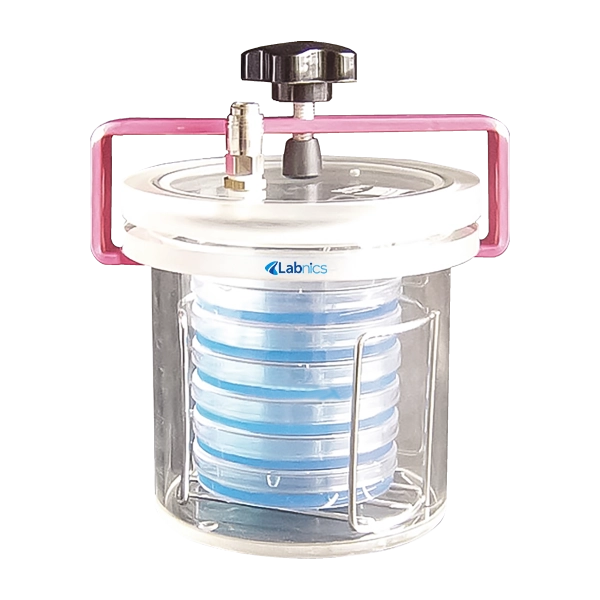Anaerobic Jar System NAJS-100 is an affordable, robust jar system designed for rapid generation an oxygen-free environment necessary to cultivate anaerobic, microaerophiles, and capnophiles microorganisms within a sealed jar. With excellent airtight performance, it aids in easy and exact, repeatable creation of desired environments for clinical and microbiology use. It is the most commonly used for anaerobiosis and is perfect for a laboratory having less sample load.
FAQ for Anaerobic Jar System NAJS-100
1: Why is PMMA material used in the construction of the Anaerobic Jar System NAJS-100?
The Anaerobic Jar System NAJS-100 is built with shock- and impact-resistant PMMA material, which provides durability while maintaining transparency for easy monitoring during experiments.
2: How does the Anaerobic Jar System NAJS-100 maintain airtight conditions during operation?
Our Anaerobic Jar System NAJS-100 ensures excellent airtight performance through its leak-resistant O-ring seal and strong stainless steel clamp, preventing any oxygen entry during incubation.
3: Can the Anaerobic Jar System NAJS-100 be used repeatedly with consistent results?
Yes, the Anaerobic Jar System NAJS-100 is designed for repeatable and accurate creation of anaerobic conditions, making it reliable for consistent experimental outcomes.
4: What is the role of the electrostatic-coated lid in the Anaerobic Jar System NAJS-100?
The electrostatic-coated lid of the Anaerobic Jar System NAJS-100 enhances durability by providing strong resistance to corrosion, wear, and chemical exposure, ensuring reliable long-term performance in laboratory environments.
5: What types of microorganisms can be cultured using the Anaerobic Jar System NAJS-100?
The Anaerobic Jar System NAJS-100 is specifically designed to support the growth of anaerobic, microaerophilic, and capnophilic microorganisms by maintaining an oxygen-free environment inside the sealed chamber.
6: How does the transparent construction of the Anaerobic Jar System improve usability?
The transparent PMMA body and lid enable clear visual monitoring of cultures throughout the incubation period without requiring the jar to be opened. This feature is especially useful for observing microbial growth while maintaining the anaerobic environment. It helps minimize disruptions, reduces the chance of contamination, and ensures reliable culture results.
7: What should I do if the Anaerobic Jar System fails to create or maintain anaerobic conditions?
Check that the lid is securely clamped and the O-ring is intact and properly positioned. Inspect for any leaks or damage to the jar and lid. Also, ensure the gas generation pack is appropriate for the jar size, correctly activated, and not expired. Proper maintenance and correct assembly are essential for optimal performance.
8: How does the electrostatic-coated lid enhance the durability and performance of the Anaerobic Jar System?
The electrostatic-coated lid provides strong resistance to corrosion and surface wear, enhancing its durability. This ensures the lid remains reliable and maintains a secure seal even after repeated use and cleaning in laboratory conditions.
9: Can the Anaerobic Jar System be used in both clinical laboratories and research institutes?
Yes, the Anaerobic Jar System is commonly used in clinical and microbiological laboratories, as well as research facilities, where precise control of oxygen-free conditions is essential. It provides a reliable and consistent environment for cultivating anaerobic and oxygen-sensitive microorganisms, making it a valuable tool for both routine diagnostics and scientific investigations.



